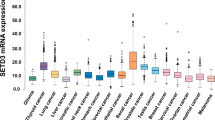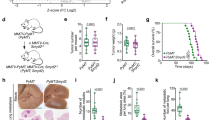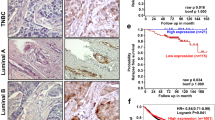Abstract
Synemin (SYNM) is a type IV intermediate filament that has recently been shown to interact with the LIM domain protein zyxin, thereby possibly modulating cell adhesion and cell motility. Owing to this multiplicity of potential functions relevant to cancer development, we initiated a study to decipher SYNM expression and regulation in benign human breast tissue and breast cancer. Dot blot array analysis showed significant SYNM mRNA downregulation in 86% (n=100, P<0.001) of breast cancers compared with their normal tissue counterparts, a result that was confirmed by real-time PCR analysis (n=36, P<0.0001). Immunohistochemistry analysis showed abundant SYNM protein expression in healthy myoepithelial breast cells, whereas SYNM expression loss was evident in 57% (n=37, P<0.001) of breast cancer specimens. Next, we analyzed methylation of the SYNM promoter to clarify whether the SYNM gene can be silenced by epigenetic means. Indeed, methylation-specific PCR analysis showed tumor-specific SYNM promoter methylation in 27% (n=195) of breast cancers. As expected, SYNM promoter methylation was tightly associated (P<0.0001) with SYNM expression loss. In-depth analysis of the SYNM promoter by pyrosequencing showed extensive CpG methylation of DNA elements supposed to regulate gene transcription. Demethylating treatment of SYNM methylated breast cancer cell lines with 5-aza-2-deoxycytidine clearly reestablished the SYNM expression. Statistical analysis of the patient cohort showed a close association between SYNM promoter methylation and unfavorable recurrence-free survival (hazard ratio=2.941, P=0.0282). Furthermore, SYNM methylation positively correlated with lymph node metastases (P=0.0177) and advanced tumor grade (P=0.0275), suggesting that SYNM methylation is associated with aggressive forms of breast cancer. This is the first study on the epigenetic regulation of the SYNM gene in a cancer entity. We provide first hints that SYNM could represent a novel putative breast tumor suppressor gene that is prone to epigenetic silencing. SYNM promoter methylation may become a useful predictive biomarker to stratify breast cancer patients’ risk for tumor relapse.
This is a preview of subscription content, access via your institution
Access options
Subscribe to this journal
Receive 50 print issues and online access
$259.00 per year
only $5.18 per issue
Buy this article
- Purchase on Springer Link
- Instant access to full article PDF
Prices may be subject to local taxes which are calculated during checkout







Similar content being viewed by others
Accession codes
References
Beckerle MC . (1986). Identification of a new protein localized at sites of cell-substrate adhesion. J Cell Biol 103: 1679–1687.
Bellin RM, Huiatt TW, Critchley DR, Robson RM . (2001). Synemin may function to directly link muscle cell intermediate filaments to both myofibrillar Z-Lines and costameres. J Biol Chem 276: 32330–32337.
Bellin RM, Sernett SW, Becker B, Ip W, Huiatt TW, Robson RM . (1999). Molecular characteristics and interactions of the intermediate filament protein synemin. Interactions with alpha-actinin may anchor synemin-containing heterofilaments. J Biol Chem 274: 29493–29499.
Bharadwaj S, Thanawala R, Bon G, Falcioni R, Prasad GL . (2005). Resensitization of breast cancer cells to anoikis by tropomyosin-1: role of rho kinase-dependent cytoskeleton and adhesion. Oncogene 24: 8291–8303.
Bilak SR, Sernett SW, Bilak MM, Bellin RM, Stromer MH, Huiatt TW et al. (1998). Properties of the novel intermediate filament protein synemin and its identification in mammalian muscle. Arch Biochem Biophys 355: 63–76.
Blake DJ, Martin-Rendon E . (2002). Intermediate filaments and the function of the dystrophin-protein complex. Trends Cardiovasc Med 12: 224–228.
Brandes JC, Carraway H, Herman JG . (2007). Optimal primer design using the novel primer design program: MSPprimer provides accurate methylation analysis of the ATM promoter. Oncogene 26: 6229–6237.
Caldeira JR, Prando EC, Quevedo FC, Neto FA, Rainho CA, Rogatto SR . (2006). CDH1 promoter hypermethylation and E-cadherin protein expression in infiltrating breast cancer. BMC Cancer 6: 48.
Cameron EE, Bachman KE, Myohanen S, Herman JG, Baylin SB . (1999). Synergy of demethylation and histone deacetylase inhibition in the re-expression of genes silenced in cancer. Nat Genet 21: 103–107.
Clark SJ, Harrison J, Paul CL, Frommer M . (1994). High sensitivity mapping of methylated cytosines. Nucleic Acids Res 22: 2990–2997.
Dahl E, Kristiansen G, Gottlob K, Klaman I, Ebner E, Hinzmann B et al. (2006). Molecular profiling of laser-microdissected matched tumor and normal breast tissue identifies karyopherin alpha2 as a potential novel prognostic marker in breast cancer. Clin Cancer Res 12: 3950–3960.
Dahl E, Sadr-Nabavi A, Klopocki E, Betz B, Grube S, Kreutzfeld R et al. (2005). Systematic identification and molecular characterization of genes differentially expressed in breast and ovarian cancer. J Pathol 205: 21–28.
Deugnier MA, Teuliere J, Faraldo MM, Thiery JP, Glukhova MA . (2002). The importance of being a myoepithelial cell. Breast Cancer Res 4: 224–230.
Dobrovic A, Simpfendorfer D . (1997). Methylation of the BRCA1 gene in sporadic breast cancer. Cancer Res 57: 3347–3350.
Elston EW, Ellis IO . (1993). Method for grading breast cancer. J Clin Pathol 46: 189–190.
Etienne J, Brault D, Firmin S . (1990). [‘Cis’ and ‘Trans’ Regulator Elements of Transcription]. Ann Biol Clin (Paris) 48: 681–694.
Ferguson AT, Evron E, Umbricht CB, Pandita TK, Chan TA, Hermeking H et al. (2000). High frequency of hypermethylation at the 14-3-3 sigma locus leads to gene silencing in breast cancer. Proc Natl Acad Sci USA 97: 6049–6054.
Granger BL, Lazarides E . (1980). Synemin: a new high molecular weight protein associated with desmin and vimentin filaments in muscle. Cell 22: 727–738.
Guarino M . (2007). Epithelial-mesenchymal transition and tumour invasion. Int J Biochem Cell Biol 39: 2153–2160.
Herman JG, Graff JR, Myohanen S, Nelkin BD, Baylin SB . (1996). Methylation-specific PCR: a novel PCR assay for methylation status of CpG islands. Proc Natl Acad Sci USA 93: 9821–9826.
Herrmann H, Bar H, Kreplak L, Strelkov SV, Aebi U . (2007). Intermediate filaments: from cell architecture to nanomechanics. Nat Rev Mol Cell Biol 8: 562–573.
Hirako Y, Yamakawa H, Tsujimura Y, Nishizawa Y, Okumura M, Usukura J et al. (2003). Characterization of mammalian synemin, an intermediate filament protein present in all four classes of muscle cells and some neuroglial cells: co-localization and interaction with type iii intermediate filament proteins and keratins. Cell Tissue Res 313: 195–207.
Hoque MO, Kim MS, Ostrow KL, Liu J, Wisman GB, Park HL et al. (2008). Genome-wide promoter analysis uncovers portions of the cancer methylome. Cancer Res 68: 2661–2670.
Kristensen LS, Nielsen HM, Hansen LL . (2009). Epigenetics and cancer treatment. Eur J Pharmacol 625: 131–142.
Lakhani SR, O'Hare MJ . (2001). The mammary myoepithelial cell—cinderella or ugly sister? Breast Cancer Res 3: 1–4.
Luscher B . (2001). Function and regulation of the transcription factors of the Myc/Max/Mad network. Gene 277: 1–14.
Mizuno Y, Thompson TG, Guyon JR, Lidov HG, Brosius M, Imamura M et al. (2001). Desmuslin, an intermediate filament protein that interacts with alpha-dystrobrevin and desmin. Proc Natl Acad Sci USA 98: 6156–6161.
Mook S, Schmidt MK, Viale G, Pruneri G, Eekhout I, Floore A et al. (2009). The 70-gene prognosis-signature predicts disease outcome in breast cancer patients with 1-3 positive lymph nodes in an independent validation study. Breast Cancer Res Treat 116: 295–302.
Nguyen M, Lee MC, Wang JL, Tomlinson JS, Shao ZM, Alpaugh ML et al. (2000). The human myoepithelial cell displays a multifaceted anti-angiogenic phenotype. Oncogene 19: 3449–3459.
Noetzel E, Veeck J, Niederacher D, Galm O, Horn F, Hartmann A et al. (2008). Promoter methylation-associated loss of ID4 expression is a marker of tumour recurrence in human breast cancer. BMC Cancer 8: 154.
Omary MB, Coulombe PA, McLean WH . (2004). Intermediate filament proteins and their associated diseases. N Engl J Med 351: 2087–2100.
Pan Y, Jing R, Pitre A, Williams BJ, Skalli O . (2008). Intermediate filament protein synemin contributes to the migratory properties of astrocytoma cells by influencing the dynamics of the actin cytoskeleton. FASEB J 22: 3196–3206.
Remmele W, Stegner HE . (1987). [Recommendation for uniform definition of an immunoreactive score (irs) for immunohistochemical estrogen receptor detection (ER-ICA) in breast cancer tissue]. Pathologe 8: 138–140.
Schmitt-Graeff A, Jing R, Nitschke R, Desmouliere A, Skalli O . (2006). Synemin expression is widespread in liver fibrosis and is induced in proliferating and malignant biliary epithelial cells. Hum Pathol 37: 1200–1210.
Sobin LH, Wittekind Ch . (1997). TNM Classification of Malignant Tumours. Wiley: New York.
Sun N, Huiatt TW, Paulin D, Li Z, Robson RM . (2009). Synemin interacts with the LIM domain protein zyxin and is essential for cell adhesion and migration. Exp Cell Res 3: 491–505.
Tang X, Khuri FR, Lee JJ, Kemp BL, Liu D, Hong WK et al. (2000). Hypermethylation of the death-associated protein (DAP) kinase promoter and aggressiveness in stage i non-small-cell lung cancer. J Natl Cancer Inst 92: 1511–1516.
Tawk M, Titeux M, Fallet C, Li Z, Daumas-Duport C, Cavalcante LA et al. (2003). Synemin expression in developing normal and pathological human retina and lens. Exp Neurol 183: 499–507.
Titeux M, Brocheriou V, Xue Z, Gao J, Pellissier JF, Guicheney P et al. (2001). Human synemin gene generates splice variants encoding two distinct intermediate filament proteins. Eur J Biochem 268: 6435–6449.
Van Rossen E, Vander BS, van Grunsven LA, Reynaert H, Bruggeman V, Blomhoff R et al. (2009). Vinculin and cellular retinol-binding protein-1 are markers for quiescent and activated hepatic stellate cells in formalin-fixed paraffin embedded human liver. Histochem Cell Biol 131: 313–325.
Veeck J, Niederacher D, An H, Klopocki E, Wiesmann F, Betz B et al. (2006). Aberrant methylation of the Wnt antagonist SFRP1 in breast cancer is associated with unfavourable prognosis. Oncogene 25: 3479–3488.
Veeck J, Noetzel E, Bektas N, Jost E, Hartmann A, Knuchel R et al. (2008). Promoter hypermethylation of the SFRP2 gene is a high-frequent alteration and tumor-specific epigenetic marker in human breast cancer. Mol Cancer 7: 83.
Whipple RA, Balzer EM, Cho EH, Matrone MA, Yoon JR, Martin SS . (2008). Vimentin filaments support extension of tubulin-based microtentacles in detached breast tumor cells. Cancer Res 68: 5678–5688.
Widschwendter M, Jones PA . (2002). DNA methylation and breast carcinogenesis. Oncogene 21: 5462–5482.
Wiesmann F, Veeck J, Galm O, Hartmann A, Esteller M, Knuchel R et al. (2009). Frequent loss of endothelin-3 (EDN3) expression due to epigenetic inactivation in human breast cancer. Breast Cancer Res 11: R34.
Yang X, Yan L, Davidson NE . (2001). DNA methylation in breast cancer. Endocr Relat Cancer 8: 115–127.
Acknowledgements
We thank Sonja von Serényi and Sevim Alkaya for excellent technical assistance and Monika Klinkhammer-Schalke, as well as Armin Pauer from the Tumor Registry Regensburg for continuous help in obtaining clinical follow-up data. We are thankful to Professor Matthias Dürst (Friedrich-Schiller University Jena, Germany) for kindly providing patient samples and follow-up data. This work is a research project within the German Human Genome Project and has been supported by the BMBF Grants 01KW0401 to ED.
Author information
Authors and Affiliations
Corresponding author
Ethics declarations
Competing interests
The authors declare no conflict of interest.
Additional information
Supplementary Information accompanies the paper on the Oncogene website
Supplementary information
Rights and permissions
About this article
Cite this article
Noetzel, E., Rose, M., Sevinc, E. et al. Intermediate filament dynamics and breast cancer: Aberrant promoter methylation of the Synemin gene is associated with early tumor relapse. Oncogene 29, 4814–4825 (2010). https://doi.org/10.1038/onc.2010.229
Received:
Revised:
Accepted:
Published:
Issue Date:
DOI: https://doi.org/10.1038/onc.2010.229
Keywords
This article is cited by
-
A risk model of gene signatures for predicting platinum response and survival in ovarian cancer
Journal of Ovarian Research (2022)
-
A 25-gene classifier predicts overall survival in resectable pancreatic cancer
BMC Medicine (2017)
-
Promoter hypermethylation profiling of distant breast cancer metastases
Breast Cancer Research and Treatment (2015)
-
Synemin: an evolving role in tumor growth and progression
Journal of Cachexia, Sarcopenia and Muscle (2014)
-
Review on intermediate filaments of the nervous system and their pathological alterations
Histochemistry and Cell Biology (2013)



